Themes > Features
22.01.2002
The Threat of an Industrial Recession
The provisional estimates
of the Index of Industrial Production for November 2000 released recently
by the CSO suggest that industrial growth during the first eight months of
fiscal year 2000-01 (April-November) has fallen to a low of 2.2 per cent
from the not-too-creditable 5.7 per cent during the corresponding period
of the previous year. If this trend persists, the overall trend rate of
growth during the decade 1991-92 to 2000-01, which was the decade of
accelerated economic reform, is likely to be worse than during the
immediately preceding ten years.
As Chart 1 shows, the trend
rate of growth during the years 1991/2-1999/2000 was, at 6.7 per cent,
exactly the same as during the years 1981/82-1990/91. However,
protagonists of reform have argued that 1991-92 was an unusual year of
adjustment, and should be ignored when estimating the trend rate. But even
during the period 1992-2000, the growth rate was only marginally higher at
7.3 per cent, and is likely to fall significantly for the period
1992-2001, if the annual rate of growth in 2000-2001 remains close to the
2.2 per cent recorded during the first eight month of that years. Thus, in
terms of the aggregate rate of industrial growth there appears to be
little difference in industrial performance during the 1980s and 1990s.

It is indeed true that the
IIP is only a lead indicator, that in the past has been known not to be
too reliable an indicator of actual trends in the registered industrial
sector as revealed by output and value added figures from the Annual
Survey of Industries (ASI), that become available only after a two year
gap. An index capturing movement in production as suggested by
inter-temporal production relatives, the reliability of the IIP can be
adversely affected by its inadequate coverage and persistent problems of
poor response from reporting units. However, it is indeed surprising that
during the 1990s the IIP seems to track quite well movements in GDP at
factor cost from the industrial sector defined to include Manufacturing,
Construction, Electricity, Gas and Water Supply. The latter figure
includes production in both registered and unregistered units. While it
may be true that the provisional industrial GDP figures for the most
recent years are computed using trends suggested by the IIP, pending the
release of ASI estimates, the long term correspondence between the two
growth series mapped in Chart 2, strengthens the reliability of the trend
indicated by the IIP.

Further, the growth figures
as revealed by the GDP at factor cost in registered manufacturing, which
are available separately for 1990-91 to 1994-95 with 1980-81 as base and
for 1994-95 to 1998-99 with 1993-94 as base, point to a similar trend in
the IIP over time, though the figures using base 1993-94 yield much higher
growth rates than both the older National Accounts Series and the IIP.
Overall it appears that
during the 1990s the IIP does provide a reasonable guide to industrial
trends despite its many shortcomings. Using the IIP therefore, we could
argue that after falling sharply in 1991-92 as a result of the import
compression and stabilisation resorted to by the government in response to
the balance of payments crisis, industrial growth recovered quite well,
rising to 5.6 per cent in 1993-94, 9.1 per cent in 1994-95 and 12.3 per
cent in 1995-96. After that, however, the industrial sector has witnessed
a downturn, with the rate of growth falling to 6.1 and 6.7 per cent in
1996-97 and 1997-98 and slipping further to 4.1 per cent in 1998-99. There
were signs of a recovery in 1999-2000 with the rate rising to 6.5 per
cent, but subsequently the pace of growth has slackened substantially,
standing at just 2.2 per cent during the first eight months of fiscal
2000-01. What is more, the figures on GDP at factor cost for the
industrial sector as a whole (registered and unregistered units in
Manufacturing, Construction, Electricity, Gas and Water Supply) suggest
that the decline in the growth rate in 1997-98 and 1998-99 was even
sharper than suggested by the IIP for those years.

In sum, the trend growth
rate in the IIP for the 1990s as a whole, is not just lower than what was
seen during the 1980s, but conceals two periods of sharply divergent
trends: a period of recovery and growth during the first half of the
1990s, followed by a period of slump during the second half of the 1990s,
which has recently been aggravated, after a brief promise of a possible
return to growth. If the trend of the second half of the 1990s persists
into the first half of the first decade of the new century, we can expect
that the economy would be soon afflicted by a severe industrial recession.
Chart 4 takes a closer look
at the years of the down turn, by examining quarterly growth trends
(relative to the corresponding quarter of the previous year) in the
general index as well as manufacturing IIP for the period stretching
between the second quarter of 1995 and the third quarter of 2001. The
picture here is more complex. From a peak of close to 15 per cent in
manufacturing and just below 14 per cent in the case of the general index,
growth slumped to a low of less than 3 per cent in the first quarter of
1997. This was followed by a recovery that lasted three quarters, which
took manufacturing growth to 9 per cent. But the recovery proved
short-lived and Indian industry once again experienced a slump till the
fourth quarter of 1998.In the next three quarters there was once again
some promise of a recovery, with manufacturing growth touching close to 10
per cent in the third quarter of 1999. But the downturn returned and
proved to be much longer and sharper, bringing the growth rate down to
close to 2 per cent in the second and third quarter of 2001.The threat of
a recession, even if defined stringently to occur when growth is negative
in consecutive quarters, now seems real.

Charts 5-10 examine these
trends separately for the major use-based industrial categories. It is
clear that, basic goods and intermediate goods display more or less the
same trends as the overall index. The difference really arises in the
capital and consumption goods categories. The capital goods sector appears
to have been through a longish recovery over the eight quarters between
the fourth quarter of 1997 to the fourth quarter of 1999, and then
experienced a collapse, with recent trends pointing to a major recession
afflicting the sector. Consumer durables played a major role in the
recovery in 1999-2000 and still appears to be outperforming most
industrial categories in the most recent quarters. Finally, the consumer
non-durables sector has not been performing well through most of the later
half of the 1990s.
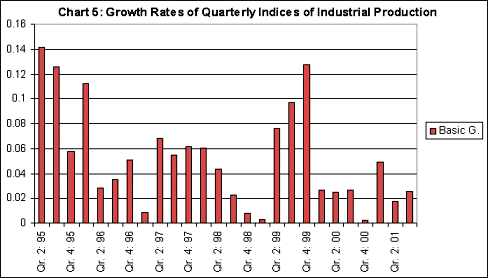
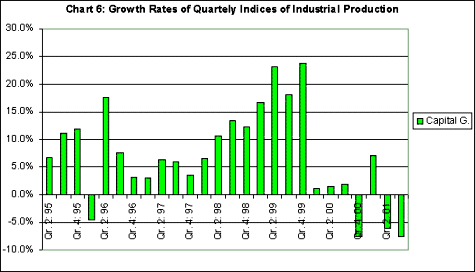
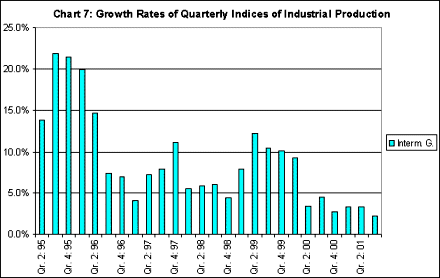
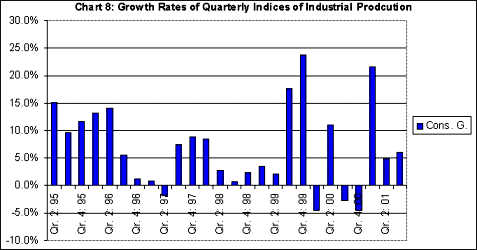
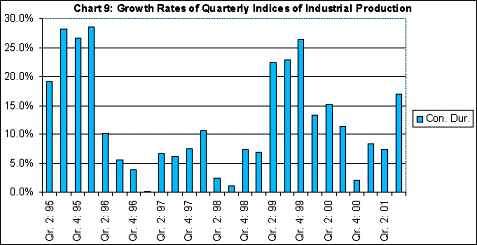

A caveat is called for at
this point. It is well known and widely accepted that the reliability of
the IIP declines when we move to more disaggregated levels of industry.
Further, there is a substantial degree of overlap between the capital and
consumer non-durable categories. Automobiles, purchases of which for
personal use rose substantially during the 1990s, are included in the
capital goods category. So are electronic goods of certain kinds that
would be more appropriately classified as consumer-durables. This overflow
of consumer durables into the capital goods category makes it difficult to
assess the degree to which any slump or recovery in capital goods is
driven by consumer durables. It also implies that the small weight of
consumer durables in the overall index, does not do full justice to the
importance of this sector from the point of view of industrial growth.
All this is of relevance
when we seek to explain the process of growth and industrial deceleration
during the 1990s. When launching the 1990s reforms, the impression
conveyed by the advocates of reform was that in course of time the "animal
spirits" of private entrepreneurs would respond adequately to the
incentives created by liberalization. Various elements of the
liberalization programme were aimed at facilitating private investment:
the dismantling of government controls on capacity creation, production
and pricing practices of even large firms and groups; improved access to
imported capital equipment, raw materials and intermediates; easier
possibilities of technical and financial collaboration with foreign
entrepreneurs; and disinvestments of public equity to private players. It
was argued that the stimulus to private investment provided by these new
incentives would take Indian industry onto a whole new growth trajectory.
What was not recognised was
that the change in policy stance in the 1990s should not just provide the
expected stimulus, but that that stimulus had to be strong enough to
counter a number of adverse implications of the reforms for manufacturing
and industrial growth. To start with, it was inevitable that import
liberalisation would result in some displacement of existing domestic
production either directly by imports or indirectly by new products
assembled domestically from imported inputs. Second, that the reduction in
customs duties resorted to as part of the import liberalisation package
and the direct and indirect tax concessions that were provided to the
private sector to stimulate investment, especially starting with the
budget of 1993-94, would lead to a significant reduction in the tax-GDP
ratio at the Centre by anywhere between 1.5 to 2 percentage points of GDP.
This implied that the fiscal stimulus associated with any given level of
the fiscal deficit would be lower than would have otherwise been the case.
Finally, after some initial slippage in the deficit reduction effort,
which took the fiscal deficit to relatively high levels in 1993-94, the
government has managed closer even if not full adherence to fiscal deficit
targets, so that the stimulus provided to industrial growth by state
expenditure was substantially smaller than was the case in the 1980s.
This of course leaves
unexplained the three years of remarkable growth during the mid-1990s. As
we have seen, the trend rate of industrial growth during the 1990s was
overwhelmingly influenced by the recovery and boom during the three years
starting 1993-94. In fact, this three-year mini-boom (as reflected in
movements in the IIP) is puzzling for three reasons. First, it cannot be
explained by increased fiscal stimulus from state. It is true that the
industrial recovery in 1993-94 was accompanied by a sharp rise in the
fiscal deficit of the central budget to 7.5 per cent of GDP, but the
subsequent two years actually saw a reduction in that deficit to 6.9 and
5.9 per cent respectively. Second, the years of high growth were the ones
in which the government vigorously pursued a strategy of import
liberalization and customs tariff reduction, resulting in a large inflow
of imported manufactures into the Indian market. To the extent that such
imports displaced local production catering to domestic demand, it should
have slowed down the growth in industrial output. Finally, those were
years when real interest rates had risen to extremely high levels by
historical and international standards. This also should have discouraged
industrial investment and therefore the growth of domestic production.
We therefore need to look elsewhere for features of
liberalization that spurred manufacturing production. There is one supply
side factor that may have operated in this manner. It has been known for
some time that one consequence of the complex of import substitution
policies pursued by India till the mid 1980s was the pent-up demand for a
range of manufactured goods, including specific brands of such goods.
While knowledge of these could be acquired by consumers and producers from
the international market, the products themselves could either not be
acquired within India or acquired only at prohibitive costs.
Liberalization of the kind pursued in India, which freed access to
intermediates, components and capital goods while protecting most
end-products, along with reducing tariffs substantially, allowed for the
expansion of domestic production/assembly and sale of these commodities
in a relatively short span of time. This occured at two levels : first, by
relatively small firms that combined cheap imports and domestic parts to
service what is not always correctly described as the "grey market"; and
second, by larger firms, very often in collaboration with international
producers with a well-cultivated brand image.
While such products did
have a ready market, they would not have contributed to a net addition to
domestic production to the extent that they displaced similar or other
products in the consumer's basket of purchases. If the availability of new
goods were to spur growth it needed to be accompanied by a net accretion
to demand after accounting for the displacement of previously
available "substitutes". In the short run such net additions to demand can
be financed either with the flow of hitherto unaccounted incomes into the
market for goods, or with an element of dissaving reflected by reduced
financial savings, or through increased recourse to consumer credit. There
is reason to believe that in much of urban India and some parts of rural
India, such a tendency was underway, driven by easier access to credit,
including consumer credit provided to individuals.
The
1993-1995 “mini-boom” was thus the result of a combination of several
once-for-all influences, in particular
the release of the pent-up demand
for a host of import-intensive goods, which (because of liberalization)
could be serviced through domestic assembly or production using imported
inputs and components. Once that demand had been satisfied, further growth
had to be based on an expansion of the domestic market or a surge in
exports. Since neither of these conditions was realised, industry then
entered a phase of slow growth.
It must be noted here that
the phenomenon of ‘pent-up’ demand was not restricted to those who had the
wherewithal to realize it as soon as supply-side constraints to their
realization were removed. The tendency existed among other sections as
well. As mentioned earlier, financial liberalisation had as its corollary
the entry of new financial players into the market and the diversification
of banks and non-bank financial companies into new areas of lending that
promised higher returns. One such area was lending for consumption
purposes, which substantially increased the number of people who could
access significantly large sums as credit to make lumpy purchases.
Further, the ‘windfall gains’ registered by a significant number of
central and state government employees as a result of the payment of
arrears following of the implementation of the Fifth Pay Commission’s
recommendations, also contributed to n increase in the number having the
wherewithal to contribute to such demand. It is indeed true that while
industrial firms and rich agriculturalists contributed to such pent-up
demand as well, the bulk of such purchases would be of consumer durables
by households. This explains the more consistent performance of the
consumer durables sector. And given the overflow of the consumer durables
into the capital goods category, it possibly explains the longer boom in
the capital goods sector. Put together this could shore up industrial
growth in particular years, as for example in 1999-2000, despite the small
share of consumer druables in total industrial production. It follows that
when such demand is satiated and cannot be sustained any further, the
overall tendency is towards slower industrial growth on average if other
stimuli such as state expenditure do not substitute for the once-for-all
stimulus, as was true by the end of the decade.
The above argument needs to
be clarified. Our intention is not to suggest that slow growth is an
inevitable consequence of a ‘positive’ aspect of the reform, which is what
fiscal deficit reduction is taken to be. Rather, the stress is on three
features. First, that the expectation that reforms would trigger the
“animal spirits” of private investors, spur private investment and ensure
the efficiency of such investment, has been belied. Second, that the
belief that liberalisation of import and foreign investment rules would
lead to a large inflow of foreign direct investment, which would use India
as a base for world market production, has been proven to be misplaced. If
such foreign investment had indeed come in large measure in the wake of
the reform, India would have recorded a much-needed expansion in
manufactured exports, which would have provided the stimulus for
industrial and overall economic growth. In practice, even that additional
foreign investment that did come has not been into greenfield projects and
has been targeted at the domestic market rather than at export production.
The third feature is that, even though the above expectations have
remained unrealised and though conditions have turned conducive for
increasing state expenditure and triggering growth, the neoliberal
obsession of the government with curbing the fiscal deficit has only
worsened the problem of decelerating industrial growth. At present, not
only is industry saddled with substantial excess capacity and inflation
running at historic lows, but the government has at its disposal large
stocks of foodgrains and a comfortable level of foreign exchange reserves.
Expanding expenditure, even if deficit-financed, would help expand
employment and output and in part contribute to an increase in the tax
revenues of the government. Many have argued that using the foodstocks for
a massive food-for-work programme geared to strengthening rural and urban
infrastructure is a major growth opportunity available to the government.
But its failure to respond positively to such advice has meant that the
industrial downturn threatens to transform itself into deep recession.
The failure to use the
above opportunity is, however, not just the result of an ideological
obsession with fiscal deficit reduction. It is in large part explained by
the government’s fear that the threat held out by international finance
that it would react adversely to any return to an era of high deficits is
real. The years of liberalisation have seen a substantial increase in the
presence of international financial players in India markets, through the
provision of credit, through investments in the stock markets and through
financial investments of other kinds. Any sudden decision on the part of
these players to withdraw their capital would not only result in a slump
in stockmarkets, but could also threaten the viability of many firms and
financial entities as well as precipitate a balance of payments and
currency crisis. This situation resulting from the increase in dependence
on purely financial flows generated by the reform in large part explains
the paralysis of the government in the face of what appears to be a sharp
slide into recession in India’s industrial sector.
What is worse, desperate to
find a way out, the government is resorting to all manner of means such as
bleeding public sector corporations of their surpluses, privatising them
at rock bottom prices and using unwarranted and economically indefensible
off-budget measures to generate additional funds. Unfortunately, while
these measures are proving inadequate at resolving the fiscal impasse,
they are undermining the long run growth and revenue generating potential
of the system. But as has been true in Russia, Turkey and Argentina,
international finance, led by the World Bank and the IMF, has been
unwilling to criticise such moves and push for enhanced tax and deficit
financed expenditures in their place. This is a sure means of inviting a
crisis, even when the opportunity to forestall is obvious.
© MACROSCAN 2002